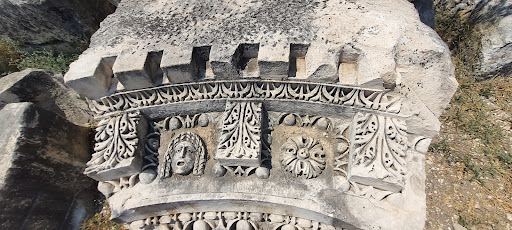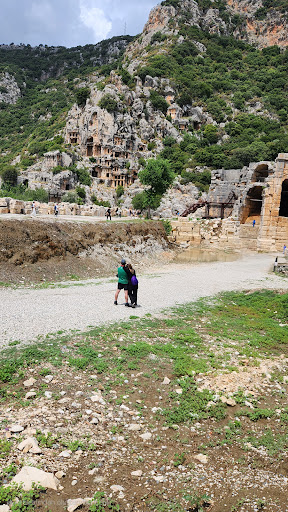MYRA ROCK GRAVES The most splendid building of Myra is the rock graves . In the 5th to 4th century BC , Myra was one of the important representatives of the Lycian Classical Period with its rock facades that imitated wooden architecture . There are two main necropo is in the east and south of the acropolis . The city of the dead , created by imitating the architecture of life beside each grave , also creates an uninterrupted panoramic city view by composing a civil settlement imitation . As well as a road network connecting the city's neighborhoods and the Acropolis and Necropolis areas , there are also passageways and rock stairs that provide access to the grave groups within each Necropolis . The differences in the type and characteristics of the tombs provide important information about the social status of the tomb owner . Rock graves are dated to 4th century BC . 23 of the graves are inscribed , 13 of them are Lycian , and 10 are ancient Greek . Except for the three of them , the tombs in the Myra necropolis , which are distinguished by their impressive reliefs on the pediment and the naos frieze , and the temple facades in the templum in antis ( Distylos in antis ) and peripteros form , are the type of house tomb , which is typologically differentiated in itself according to the covering systems and façades . There are twenty - three reliefs , which are important for their iconographies , giving information on their qualities and burial customs in 10 of the Myra rock graves . Scenes are an important group of the reliefs of the Lycian Classical Period . The temple on the eastern necropolis has a façade and the lion has a pediment in which the bull struggle takes place . In the frieze on the door , the grave owner lying . in the center is depicted on the Symposium stage with her family , while on the side is the Artemis Myrrh , the goddess of plants / nature . Another grave type named as Pictorial Grave , 11 human figures in the relief program come to the forefront with a realistic and subtle depiction of the figure . The remnants of paints ( red - blue - yellow ) . which can be seen in today even a little , show that these descriptions were painted in a very colorful style in the Classical Period . The facade of the grave was chosen as a relief . Left side there is Grave Lord who lied on the lectia with levitate riton by his hand and across him , his spouse and children , beside grave on the rock surface , is located depictions of visitors...
Read moreAn Unforgettable Journey to Myra: A Tale of Tombs and Theatrical Grandeur A visit to the ancient city of Myra offers a truly captivating glimpse into the past, with its most striking features—the rock-cut tombs and the grand Roman amphitheater—standing as a testament to the skill and artistry of a bygone era. The journey through this Lycian and Roman ruin is an experience that blends history with awe-inspiring natural beauty, making it a must-see for anyone traveling along Turkey's Turquoise Coast. The first sight to capture your imagination is undoubtedly the necropolis, where intricate rock-cut tombs are carved directly into the sheer face of the cliff. The preservation of these burial sites is remarkable. You can clearly distinguish the intricate carvings and detailed facades, some of which mimic the look of wooden houses with beams and doorways. The most famous tomb, the "Painted Tomb" (though faded), gives you a sense of the vibrant colors that once adorned these final resting places. Even without the original pigments, the sheer scale and complexity of the carvings are breathtaking. The detail on the relief sculptures, depicting scenes from daily life and mythology, is a highlight, and the fact that these delicate details have survived millennia is a tribute to their sturdy construction. Just below the cliff face lies the magnificent Roman amphitheater. While not as perfectly preserved as some others, its scale and commanding presence are undeniable. The seating tiers, though weathered by time, still rise impressively, inviting you to imagine the plays, performances, and gladiatorial contests that once filled its air. The stage building, or scaenae frons, is in a state of impressive disrepair, but enough remains to outline its original grandeur, with arched doorways and decorative niches still visible. You can climb to the upper rows, offering a stunning panoramic view of the entire site, including the nearby tombs, which makes for a perfect photo opportunity. The atmosphere here is one of peaceful reflection, allowing you to fully appreciate the city's place in ancient civilization. In conclusion, Myra offers a profound and well-preserved look into a powerful ancient culture. The rock-cut tombs and the amphitheater are the clear highlights, and their excellent condition makes it easy to visualize the city as it once was. It's a journey that leaves you with a deep appreciation for the artistry and legacy of the...
Read moreNestled in the heart of Turkey’s stunning Lycian region, Myra Ancient City is a mesmerizing testament to the rich history and cultural heritage of this remarkable land. As I approached the site, the breathtaking landscape of rugged mountains and lush greenery set the perfect backdrop for an unforgettable journey into the past.
Upon entering Myra, I was immediately struck by the grandeur of its rock-cut tombs, which stand as a testament to the ingenuity and artistry of the ancient Lycian civilization. The intricate carvings and detailed facades of these tombs, particularly the famous "Lycian Tombs," evoke a sense of reverence and wonder. It was as if I could almost hear the echoes of history whispering stories of those who once walked these very grounds.
One of the highlights of my visit was the stunning Roman Theatre, which dates back to the 2nd century AD. The well-preserved amphitheater, with its impressive seating capacity and remarkable acoustics, transports you back to a time when it was filled with the sounds of performances and gatherings. Sitting in the stands, I couldn’t help but imagine the vibrant life that once filled this space.
The serene atmosphere of Myra is further enhanced by its natural surroundings. The combination of ancient ruins and the beauty of the landscape creates a unique harmony that is both peaceful and inspiring. As I wandered through the site, I encountered beautiful flora and fauna, making the experience even more enchanting.
Visiting Myra is not just about exploring ancient ruins; it’s about connecting with history in a profound way. The site is less crowded than other tourist hotspots, allowing for a more intimate experience. It felt like I had discovered a hidden gem, a place where time stands still, and the past comes alive.
In conclusion, Myra Ancient City is a must-visit for anyone seeking to immerse themselves in the history and beauty of Turkey. Whether you’re a history enthusiast, an archaeology lover, or simply someone looking to experience the magic of ancient civilizations, Myra offers a captivating journey that will leave a lasting impression. I left with my heart full and my mind enriched, eagerly anticipating the next opportunity to return to this...
Read more


